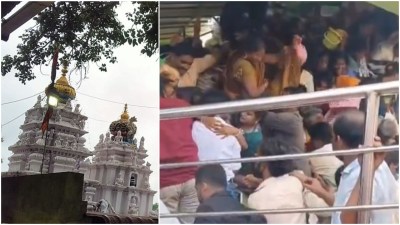On the National Highway, ten days of solitude is finally over
The RTO staff at Achhad, 120 km from Surat, will never forget this paid holiday. The whole of this week, they have played cricket with the S...

The RTO staff at Achhad, 120 km from Surat, will never forget this paid holiday. The whole of this week, they have played cricket with the STD booth-owner next door.
For them, this was a week to rest: a welcome break from the tedious job of counting 5,000 trucks that ply daily between Surat and Mumbai, easily one of the busiest stretches in the country.
If there was one place to go and get a feel of the truckers’ strike, it was here, along this 250 km stretch of National Highway 8. On any given day, the drive from Surat to Mumbai takes you six hours provided there are no traffic jams. But this whole week, it’s been a cruise: the distance covered in four hours flat.
Instead of bumper-to-bumper traffic and chaotic jams, you can spot rows of parked trucks along bays and in the compounds of big petrol pumps. Also at standstill: marble from Rajasthan, automobiles from Haryana, textiles from Surat and Ahmedabad and diesel and petrol from Hazira. After all, the NH 8 serves as the main artery for roads leading from Hazira, Jamnagar, Bhavnagar and Kandla to Mumbai in addition to the traffic from Delhi and Rajasthan.
Maharashtra government’s highway patrol has also been taking it easy. Because there are no traffic problems to sort out. ‘‘On any other day, there are at least 4-5 big accidents and it’s quite common to find queues as long as 2-3 miles,’’ says Sunil Yadav, senior inspector who patrols in a rickety Ambassador with three others. To make matters worse, there’s a 20-km stretch where there’s only a single lane.
At Vapi, a junction between Silvasa and Daman, parked trucks crowd every petrol pump, truck bay and open ground. The factories of Valsad, the plastic and chemical hub of the country, seem to have come to a standstill. Dhabas, auto-repair shops all along the highway are deserted. Bleary-eyed truck drivers sit and watch television.
The Reliance trailers, carrying export material from the Hazira plant to Mumbai port, bring up the only traffic. The driver says he has been directed to drive at night, probably to meet the deadline with the ship waiting at Mumbai.
But they pelted him with stones at Silvasa. Boulders are also being carried from the Chikhli quarry in Valsad district to the L&T plants in Hazira. A convoy of at least 10 tippers is led, followed by cars with green stickers. Men in yellow helmets are present every 500 metres to guide the convoy towards the quarries.
Cut to NH 6 in another part of the country. It’s the same story. Nazir Khan has been taking a pleasure-ride on his bullock-cart on the highway stretch between Kolaghat and Kharagpur in West Bengal.
‘‘This is really smooth, like sailing on water,’’ grins Khan, pointing to the newly-laid four-lane black top. From Bengal to Chennai, the truckers’ strike has allowed the entry on highways of bullock-carts, cycles, rickshaws and tractors. They have been crawling, trundling in every direction, every lane. But these past 10 days have been the worst for truck drivers and khalasis, stranded on highways in soaring temperatures.
The shade beneath the truck has been kitchen, bedroom and card-room for these stranded men. ‘‘It burns, it boils’’ says Ramesh Yadav, a truck driver who normally does the Jharkhand-Orissa-Bengal circuit. Near Balasore town, where striking operators put up roadblocks, they were forced to dispose loads of potatoes and onions after waiting in the sun for five days. Retailers made a mad scramble, some selling the stock at a premium by the roadside.
In Andhra, tents were set up at small towns and at road intersections near Ankapalli, East Godavari, Rajamundry, Ongole and Vijayawada. In Vijaywada, an oil company representative spoke of arrangements to provide police escorts to trucks carrying petroleum products.
Truck drivers kept track of strike over radio, deciding to move once word spread that the strike in the state had been called off. But they could only go some distance. A faction opposed to the withdrawal of the strike blocked their way.



- 01
- 02
- 03
- 04
- 05




























